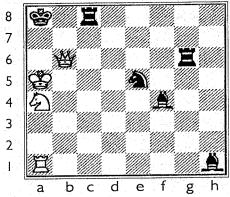
K=King, Q=Queen, R=Rook, N=Knight, B=Bishop
During June 12 to 15, 2003, at the Las Vegas Riviera Hotel, the National Open Chess Festival offered a demonstration of, and lecture on, the Turk - Wolfgang von Kempelen's famous 18th century chess playing automaton. John Gaughan, a manufacturer of professional magician's equipment, was able to duplicate the original. The project took three people five years, and a staggering cost of $120,000.
Dr. Gerald M. Levitt, noted author and authority on the Turk, spoke. "The realized goal in the construction of the pantograph was to use only the materials and methods available in the eighteenth century. The modern directors tell us that it is not a difficult piece of equipment to operate. The main problem in its operation is the stifling heat produced, for the interior lighting is provided by candles, as it was in the original."
I fell in love with the elegance and beauty of the Turk, who is dressed in velvet and fur. He and his table look like a $120,000 piece of equipment. He always gets the first move and he always wins! Three volunteers teamed to play an end game with him. (A full game would take too long.) The doors were opened to show that no man could fit into the table's cabinet full of mechanical stuff.
The end game was brilliant, and of course the Turk won - even after the three players agreed that the Turk was starting with a disadvantage.

K=King, Q=Queen, R=Rook, N=Knight, B=Bishop
Positions: The Turk (White): K on a5, N on a4, R on a1, and Q on b6. Black: K on a8, R on c8, R on g6, B on f4, B on h1, and N on e5. Moves: 1)Nc5 Rxb6 2)Kxb6+ Kb8 3)Na6+ Ka8 4)Nc7+ Kb8 5)Ra8+ Bxa8 6)Na6 mate
It's the Turk (white) to move, and he hangs his Q, playing N to c5. Black moves his R to b6, taking the irresistible bait of the Turk's Q. The trap has now been sprung. The Turk has gained the initiative, and Black's options for the rest of the game are reduced to defensively responding to the Turk's relentless pressure.
The Turk takes Black's R with his K, in the process clearing the way for his R on a1 to put Black's K in check. Black responds by moving his K out of check to b8. The Turk moves his N to a6, again putting Black's K in check. Black responds by moving his K out of check to a8. The Turk moves his N to c7, checking Black's K again. Black moves his K back to b8. The Turk plays R to a8 - check. Since his R is held up by the Turk's N on c7, Black must use his B to take the Turk's R that is checking his K from a8. The Turk then moves his N to a6 and checkmate. The Turk started with sacrificing his queen and eventually other pieces to get this final position. A smothered N mate is unusual.
There is a game in Gerald M. Levitt's book showing how Napoleon lost to the Turk. I was astonished at how poorly Napoleon played - I think as low as a class D player in the USCF rating system. Ben Franklin, Catherine of Russia, Queen Marie Antoinette, and other notables, all lost to him. He toured the big cities in Europe, and even challenged the best players in the Parisian Cafe de la Regence - the foremost chess club of the 18th and 19th centuries, and the most famous chess club in history.
Rumors and theories began to circulate about how the automaton worked. One rumor said that a child or a midget sat in the cabinet. A child wouldn't have the skill to play the game at such a high level, and a midget of master strength was also very unlikely. Possibly a very slim, slight adult male might be inside the box.
"First hypothesis: After winding without outside interference, the machine plays games that are calculated prior to their start, in which suitable moves are calculated according to the other player's responses. Second hypothesis: The machine also played certain examples of chess games, but is not only activated by the winding, but also during the game by external intervention. Third hypothesis: The chess player is managed only by external intervention either by a magnet, or Fourth hypothesis: by hidden strings and moves. Fifth Hypothesis: A person hidden in the machine moves the Turk and manages the game.
Edgar Allan Poe wrote a paper and guessed near the mark on some points but fell wide on others. One man, suspecting a man within, blew snuff into the box and produced a sneeze. On two occasions someone yelled "Fire!" The crowd panicked and ran for the doors. The man in the box rocked the wood so badly that the box rolled over. The presenter managed to close the curtains before the man in the box charged out.
Napoleon III was so intrigued that he bought the automaton for an enormous amount of money and was terribly disappointed to find out its secret. He later sold it back.
The $50 book presents eighty-three games played by its directors with no Turk involved. I certainly recommend the book and seeing the Turk in action.